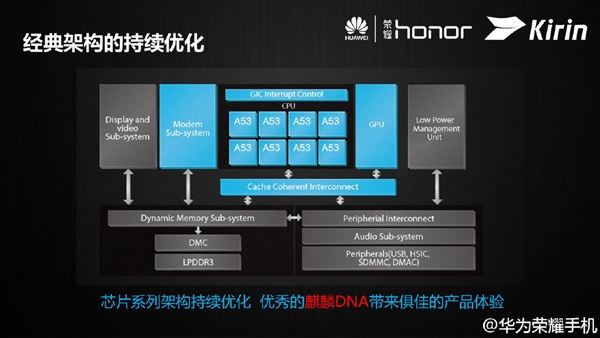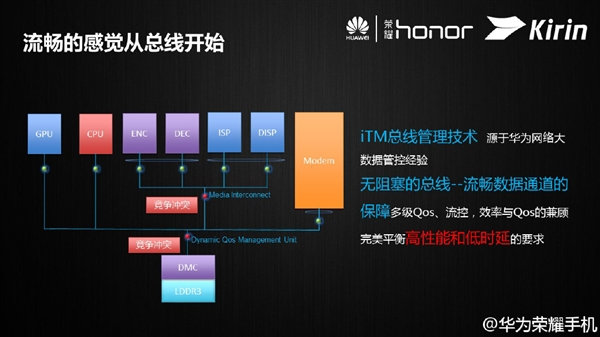Huawei / Hisilicon has announced a new 64-bit ARM processor with Kirin 620 featuring eight ARM Cortex A53 cores coupled with a Mali-450MP GPU, as well as an LTE Cat4 modem.
 Key specifications of this application processor include:
Key specifications of this application processor include:
- CPU – 8x ARM Cortex A53 @ 1.2 GHz
- GPU – Mali-450MP4 GPU
- Memory – LPDDR3
- Camera – 13MP, ZSL (Zero Shutter Lag), HDR
- Video – Decode & Encode: 1080p30 H.264
- Cellular connectivity – LET Cat4 150M/50M, HSPA+ Cat24 42M / Cat6 5.76M, TDS R7 2.8M/2.2M, GSM R6 Class33
- Voice Solution – VoLTE/eSRVCC, CSFB, SGLTE, DSDA, DSDS
- Peripherals – USB, HSIC, SD/MMC, DMAC
- Process – 28 nm
That’s about all I know so far. Hisilicon mobile SoCs have not found their way in many handsets in the past, apart from Huawei smartphones. We’ll see if that one becomes more popular.
Via AndroidPC.es and Android Headlines.

Jean-Luc started CNX Software in 2010 as a part-time endeavor, before quitting his job as a software engineering manager, and starting to write daily news, and reviews full time later in 2011.
Support CNX Software! Donate via cryptocurrencies, become a Patron on Patreon, or purchase goods on Amazon or Aliexpress. We also use affiliate links in articles to earn commissions if you make a purchase after clicking on those links.





HiSilicon shows some smart design choices in this chip. It is clearly designed to be relatively cheap to manufacture (relatively limited chip die area) while still providing good performance for low/mid-range devices.
In the past, HiSilicon has been using CPU cores with a relatively large die area such Cortex-A9 and Cortex-A15, which do not result in a particularly cheap or power-efficient chip. However, the Cortex-A53 is direct successor to the very power efficient and extremely small Cortex-A7 core, which means even with eight cores the chip will still be relatively small.
Other companies are at an advanced stage of introduction of similar SoCs, including MediaTek’s MT6752 (octa-core Cortex-A53 with Mali-T760 MP2) and Qualcomm’s Snapdragon 615 (octa-core Cortex-A53). The Cortex-A53 core is promising to significantly raise efficiency in terms of performance/Watt and performance/dollar. I think it won’t be long before we’ll see TV boxes/development boards also with this kind of SoC (for video decode, having eight cores with NEON means even software decoding when required can be smooth). Information about symmetric (not big.LITTLE) octa-core SoCs from Allwinner (A83T) and Rockchip (“Maybach”) has already surfaced. For more background on Cortex-A53 see my blog article on this subject (http://mobilesemi.blogspot.com/2014/09/early-test-results-suggest-cortex-a53.html).
Compared to MediaTek’s and Qualcomm’s new chips, the Mali-450 MP4 GPU is notable because it does not support the OpenGL ES 3.0 API. However, OpenGL ES 2.0 is still the standard in the mobile market, and HiSilicon can probably improve cost and performance this way (especially since Mali-T62x and Mali-T760 are not cheap in terms of die size). The new chip has several similarities with MediaTek’s MT6592/8392, which is almost a year old, which has eight Cortex-A7 cores and also a Mali-450 MP4 GPU (have their been any TV boxes/sticks/boards with MT8392?).
The only negative point I can see in the specs is that the CPU clock speed of 1.2 GHz is significantly lower than most other announced Cortex-A53-based SoCs. The modem is also limited to LTE Cat 4 (previous HiSilicon chips already supported Cat 6), which is probably a good thing because HiSilicon chips like Kirin 920 seemed to have a modem with relatively high power consumption and mediocre reception.